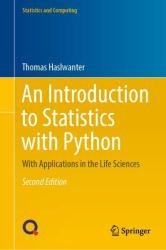An Introduction to Statistics with Python, 2nd Edition
- Добавил: literator
- Дата: 18-11-2022, 20:19
- Комментариев: 0
 Название: An Introduction to Statistics with Python: With Applications in the Life Sciences, 2nd Edition
Название: An Introduction to Statistics with Python: With Applications in the Life Sciences, 2nd EditionАвтор: Thomas Haslwanter
Издательство: Springer
Год: 2022
Страниц: 341
Язык: английский
Формат: pdf (true)
Размер: 10.05 MB
Now in its second edition, this textbook provides an introduction to Python and its use for statistical data analysis. It covers common statistical tests for continuous, discrete and categorical data, as well as linear regression analysis and topics from survival analysis and Bayesian statistics.
For this new edition, the introductory chapters on Python, data input and visualization have been reworked and updated. The chapter on experimental design has been expanded, and programs for the determination of confidence intervals commonly used in quality control have been introduced. The book also features a new chapter on finding patterns in data, including time series. A new appendix describes useful programming tools, such as testing tools, code repositories, and GUIs.
The provided working code for Python solutions, together with easy-to-follow examples, will reinforce the reader’s immediate understanding of the topic. Accompanying data sets and Python programs are also available online. With recent advances in the Python ecosystem, Python has become a popular language for scientific computing, offering a powerful environment for statistical data analysis.
My motivation for providing the solutions in Python is based on two considerations. One is that I would like them to be available to everyone. While commercial solutions like Matlab, SPSS, Minitab etc. offer powerful tools, most can only use them legally in an academic setting. In contrast, Python is completely free (as in free beer is often heard in the Python community). The second reason is that Python is the most beautiful coding language that I have yet encountered; and around 2010 Python and its documentation matured to the point where one can use it without being an serious coder. Together, this book, Python, and the tools that the Python ecosystem offers today provide a beautiful, free package that covers all the statistics that most researchers will need in their lifetime.
Compared to the first edition, the following changes have been made:
• The package pandas and its DataFrames have become an integral part of scientific Python, as has the Jupyter framework for interactive data environments. Correspondingly, a bigger amount of space has been dedicated to their introduction.
• A new package, pingouin, is promising a simplified and more powerful interface for many common statistics function. This package is introduced, and many application examples have been added.
• The visualization of data has been expanded, including the preparation of publication-ready graphics.
• The design of experiments and power analyses are discussed in more detail.
• A new section has been added on the confidence intervals of frequently used statistical parameters.
• A new chapter has been added on finding patterns in data, including an introduction to the correlation coefficient, cross- and autocorrelation. For an application of these concepts, a short introduction is given to time series analysis.
As for the first edition, all examples and solutions from this book are again available online. This includes code samples and example programs, Jupyter Notebooks with additional or extended information, as well as the data and Python code used to generate most of the figures. They can be downloaded from Github. I hope this book will help you with the statistical analysis of your data, and convey some of the often really simple ideas behind the sometimes awkwardly named statistical analysis procedures.
For Whom This Book Is:
This book assumes that:
• you have some basic programming experience: If you have done no programming previously, you may want to start out with Python using some of the great links provided in the text. Starting programming and starting statistics may be a bit much all at once. However, solutions provided to the exercises at the end of most chapters should help you to get up to speed with Python.
• you are not a statistics expert: If you have advanced statistics experience, the online help in Python and the Python packages may be sufficient to allow you to do most of your data analysis right away. This book may still help you to get started with Python. However, the book concentrates on the basic ideas of statistics and on hypothesis tests, and only the last part introduces linear regression modeling and Bayesian statistics.
This book is designed to give you all (or at least most of) the tools that you will need for statistical data analysis. I attempt to provide the background you need to understand what you are doing. I do not prove any theorems, and do not apply mathematics unless necessary. For all tests, a working Python program is provided. In principle, you just have to define your problem, select the corresponding program, and adapt it to your needs. This should allow you to get going quickly, even if you have little Python experience. This is also the reason why I have not provided the software as one single Python package; I expect that you will have to tailor each program to your specific setup (data format, etc.).
Скачать An Introduction to Statistics with Python, 2nd Edition
[related-news] [/related-news]
Внимание
Уважаемый посетитель, Вы зашли на сайт как незарегистрированный пользователь.
Мы рекомендуем Вам зарегистрироваться либо войти на сайт под своим именем.
Уважаемый посетитель, Вы зашли на сайт как незарегистрированный пользователь.
Мы рекомендуем Вам зарегистрироваться либо войти на сайт под своим именем.
